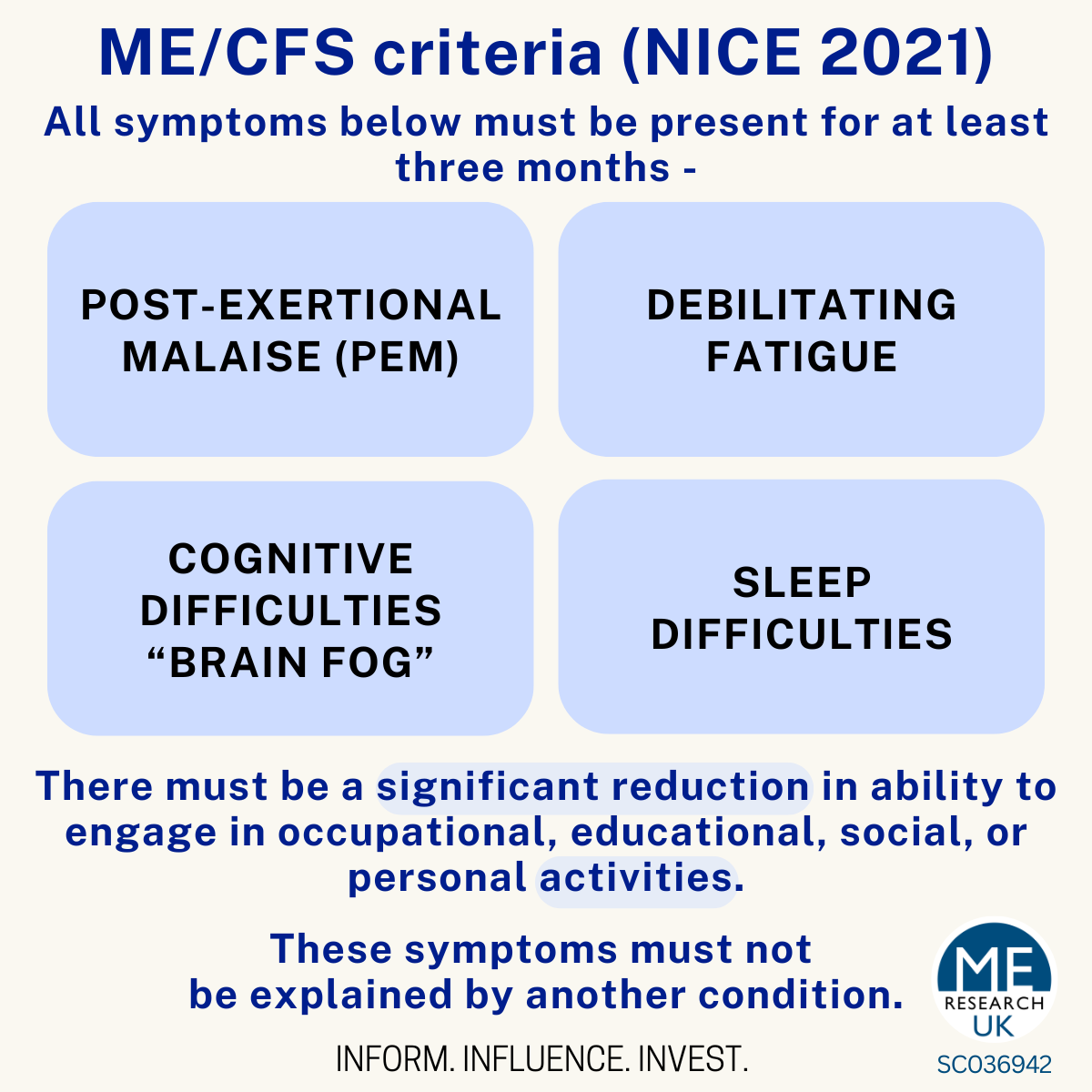The NICE 2021 guideline for ME/CFS outlines the criteria necessary for diagnosing the disease. Officially produced for use in England, it was formally endorsed in Northern Ireland in 2022, and in 2025 the Scottish Government announced that this guideline would serve as “the default clinical guidance on ME/CFS” in Scotland. Additionally, in Wales, there is “an agreement that all NICE guidelines and quality standards are available for use”.
NICE 2021 diagnostic criteria for ME/CFS
According to NICE, “…there currently is no diagnostic test for ME/CFS, and it is recognised on clinical grounds alone.”
A diagnosis of ME/CFS requires that all of the following symptoms are present for at least three months, with a significant reduction in the ability of the individual to engage in occupational, educational, social or personal activities, compared to pre-illness levels. These symptoms must not be explained by another condition.
- Debilitating fatigue
- Post-Exertional Malaise (PEM) – a delayed worsening of symptoms following minor physical or mental exertion
- Unrefreshing sleep and/or sleep disturbances
- Cognitive difficulties, commonly referred to as “brain fog”
ME/CFS can be further classified according to severity as Mild, Moderate, Severe or Very Severe.
NICE also highlights the following symptoms as being associated with, but not exclusive to, ME/CFS:
- Pain
- Orthostatic intolerance (symptoms upon assuming an upright posture)
- Autonomic dysfunction (improperly functioning nervous system)
- Flu-like symptoms
- Sensory hypersensitivity
- Neuromuscular symptoms (such as twitching)
- Intolerance to alcohol, food or chemicals
Diagnostic approach
According to NICE, if ME/CFS is suspected, physicians should conduct a comprehensive assessment including:
- Medical history and physical examination
- Assessment of the impact on psychological and social wellbeing
- Investigations to rule out other diagnoses, such as blood tests for vitamin D, vitamin B12 and folate levels, and for a history of infection
The guideline states, “In many cases, symptoms are thought to have been triggered by an infection but it is not simple post-illness fatigue.”
Other criteria
Other diagnostic/research criteria relevant to the disease that are often referenced include:
- Canadian Consensus Criteria (CCC) for ME/CFS
- Institute of Medicine (IOM) Criteria for ME/CFS
- International Consensus Criteria (ICC) for ME
- Fukuda Criteria for CFS (declining in usage)
It is important to note that, while there are commonalities, different criteria emphasise different combinations of symptoms necessary for a diagnosis. However, PEM (or equivalent), fatigue and sleep dysfunction are generally considered core components across most diagnostic frameworks.
Other frequently cited symptoms include cognitive difficulties, pain, orthostatic intolerance and flu-like symptoms.
PEM is widely considered the cardinal feature of ME/CFS.
Misdiagnosis
Misdiagnosis is a significant concern in ME/CFS, particularly if PEM is not properly recognised.
Many healthcare professionals lack sufficient knowledge about ME/CFS, increasing the risk of misdiagnosis. Furthermore, overlapping symptoms such as fatigue, sleep disturbances and cognitive difficulties can lead to confusion with conditions such as:
- Chronic diseases with fatigue (e.g. fibromyalgia)
- Sleep disorders (e.g. sleep apnoea)
- Psychiatric illnesses (e.g. depression, anxiety, PTSD)
Thorough assessment and accurate diagnosis are crucial to ensure appropriate management and to improve the quality of life of individuals with ME/CFS.



